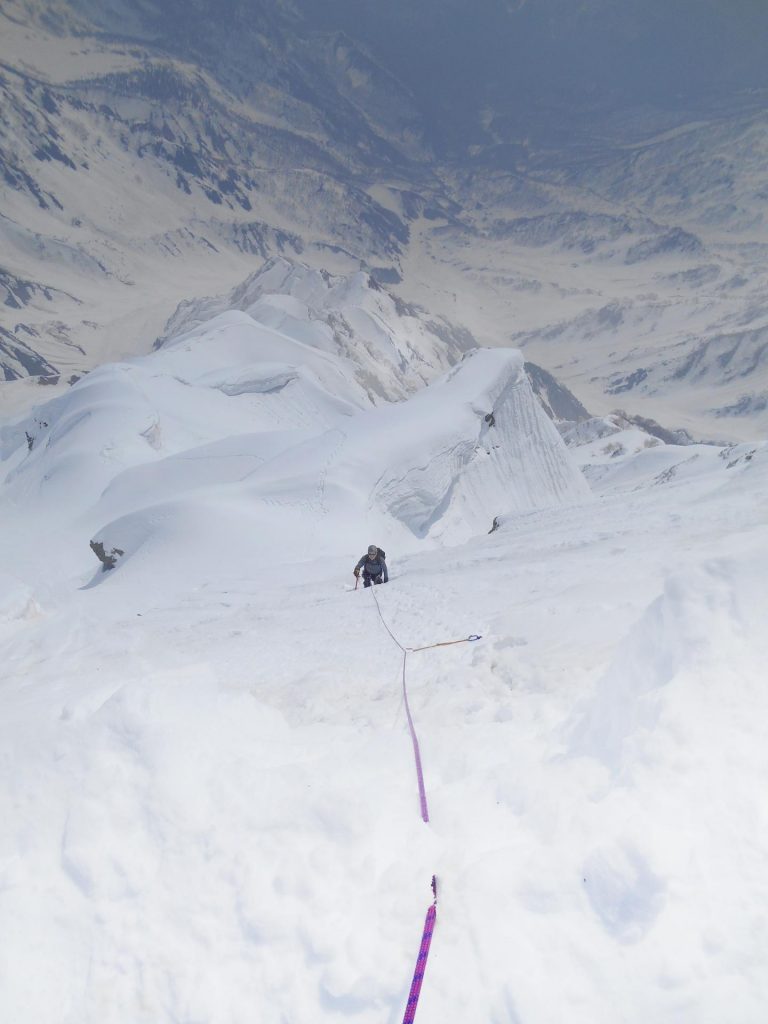Glancing down to check my footing, I tried to ignore the forty meters of rope snaking down below me without a single piece of protection securing it to the steep snow of Mt. Shirouma’s famous headwall. I knew that Michael was anchored to a good piton in a solid rock protruding from the snow but, if I fell here, it would be a big one.
Spreading my weight and thinking light thoughts, I kicked a few more steps upwards to just below the overhanging cornice that marks the transition from the East Face to the summit. I then unclipped the snow stake from my harness. It went in like a hot knife through butter…probably not much use here, but it would have to be enough. “Breathe,” I told myself, savoring the jaw-dropping exposure of this moment I’d been dreaming of for month.
How did this moment come to pass? As so many plans do, it started with a photo in a book and a name on a map. At 2,932 meters, Mt. Shirouma (白馬岳), or “The White Horse,” is the queen of Hakuba’s giants: the chain of peaks that runs north to south on the eastern edge of the North Alps of Japan. This is big snow country, and people flock here in winter to ski the famous powder resorts on the flanks of the mountains.
As luck would have it, there is a direct route to the summit up the main ridge of the East Face. In summer it is so steep and loose that it would be madness to go near it, and in winter the deep snow rules it out. But in April, when the spring temperatures arrive and the snow consolidates, a window opens up for those with the right skills and experience to pass through.
I first became acquainted with the main ridge, Shu-ryo (主稜), of Mt. Shirouma while perusing the “Challenge! Alpine Climbing” guidebook. The color photo on page 27 was a side shot of climbers pitching the headwall at the top of the East Face. The image grabbed me and wouldn’t let go. What would it feel like to be up there, adrift, with the whole East Face dropping off below your boots? There was only one way to find out.
Shouldering heavy packs full of camping and climbing gear, Michael and I began the short hike from the Sarukura Trailhead in the late afternoon. An hour later we chose a safe site for our tent at Shiroumajiri and began leveling out a platform. We had deliberately chosen the day before the start of the Golden Week holidays for our ascent, and were pleased to be the only tent. The ridge would be ours alone.
After a quick breakfast we donned harnesses and crampons and set off in the darkness, crunching our way up the firm lower slopes to gain the ridge. It pays to set out early on snow routes like this, to get as far up the ridge as possible before the mid-morning sun wreaks havoc. As the sun rose behind us, we hit the start of the ridge proper.
The Shu-ryo is a series of rising peaks and bumps, numbered in sequence from P8 at the top of the approach slopes all the way up to P1—the summit itself. Connecting these peaks is a thrilling knife-edge snow ridge, with a total height-gain from basecamp to summit of approximately 1,400 meters. In places the ridge is overhung on one side with huge whipped cream cornices. We took care to stay well away from these.
At P5 things opened out and began to steepen, and we could feel our excitement rising. Conditions were perfect, and we made quick progress. By mid-morning we were front-pointing up the final knife-edged arête to the top of P2, the last resting spot at the foot of the infamous headwall. As Michael pulled over onto the small flat perch, I unpacked the rope and contemplated the line I should take. The headwall is approximately sixty meters high and exposed on all sides to enormous drops. Our rope was fifty meters long, so it would take two pitches. Twenty minutes later I was reaching up with my ice axe to begin hacking out an exit through the fabled cornice.
As I pulled over onto the flat summit, I felt elated. Walking several meters back from the cornice I sank the shafts of both axes into the snow, equalized them for an anchor, and shouted to Michael to take me off belay. As he climbed the pitch, I couldn’t resist whipping my camera out to take the classic shot of him on the headwall, the whole East Face sweeping down below him.
Temperatures were now quite high, and we jogged down the Daisekkei in our base layers, anxious to minimize our time in the avalanche zone. After striking camp and packing up, we looked back at the perfect route we had just climbed. Bidding farewell to The White Horse, we headed back down in the direction of our car and wherever the next dream might lead us.








